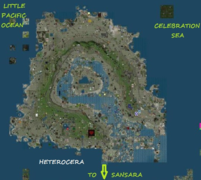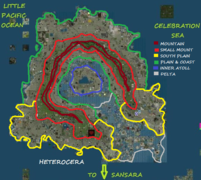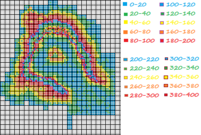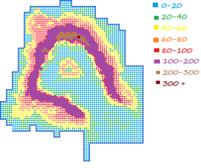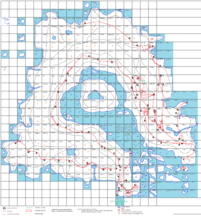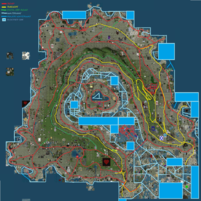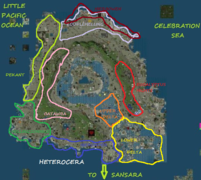Heterocera
Heterocera (or Atoll Continent) is the second historical mainland continent. It has the most advanced transportation systems of all mainland continents. This includes: a vast railway system, the most complex road system and internal and external waterways. The Geographical features are unique and are composed of vast plains, coasts, mountains, corals and hills. Heterocera is the most populated continent, with the smallest percent of abandoned land and also the continent with the smallest percent of places to rent.
It is linked to Sansara by the ANWR channel (see Transcontinental Channels).
History
The first sims were created in March, 21th, 2005, starting from Calleta region. In December 2nd, 2005, the continent was complete. The first sims created were the ones in South, then the ones in North East. The North West corner was built the last. A daily evolution of all mainland continents can be seen here:[1]. So, the construction of this continent took 257 days.
Heterocera was originally created around an "abandoned civilization" theme, much like what was done with Nova Albion, and later with Nautilus City. Magellan Linden documented these features on his blog. Centered on the Moth Temple in Iris🖈, the original builds included artifacts like causeways and shacks; many of these were removed or altered once the land was sold. In keeping with the temple theme and continent name, nearly all regions on the atoll are named after moth species.
The inventory library includes assets to reproduce or match many of the original features. These are under Library/Objects/Atoll continent stuff, Library/Textures/Atoll Textures, and Library/Terrain Textures/Atoll terrain textures.
After the original construction period, the geographic features remained unchanged. The most important changes were made on the railway system, that expanded until 2013.
Geography
The land features are very complex and respects a specific symmetry patern.
Inner Structure
The following structures are from center exterior.
The inner lake (Zygaena) is small, the size of two sims. It is not connected to the ocean. The bigest part of the lake is inside Zygaena sim. The lake floor is smooth, gray and populated with a small number of sea plants. In the center of the lake, there is an abandoned notecard giver. Even if the lake is small, it has its own port and even submarines. Also, the inner lake is 40 meters above sea level. It looks like a lake with sweet water.
Inner Atoll has a circular shape and is formed of a ring of low mountains (or hills) around the inner lake. To the exterior, the mountains are smaller and are replaced with smaller hills. The inner atoll has two roads that form two rings, one close to the inner shore and one near the outer shore.
The Larger Lake has a circular shape, around the inner atoll. Water is not deep, but navigation is not a problem. The lake is usually one sim wide (in East), but expands up to more then two sims in some parts in West. The lake is full of polders (artificial islands). Also, there are many coral islands that usually don't rise more then 1 meter above sea level. To create an island is sometimes very easy, since in many places water is less then 4 meters deep, so an island could be easy created by terraform. The lake floor is covered with corals. The local fish and algae population is not high. The outer lake has many big and small ports.
The Inner Delta is the water structure that connects the outer lake with the ocean. Usually, the water is not deep (sometimes less then 4 meters). Many wooden bridges connect the shores with the parcels inside the delta. These bridges are usually about 50 cm above water, but sometimes they are higher, to allow ships to pass. The navigation ways are protected land. On the map, they are visible as channels inside the delta. There are some places called Void. These are protected waters and usually are deeper. The temple of Isis is the center of the delta. More information is available at Heterocera Inner Waters.
Outer Atoll
The following structures form paralel rings from the continent interior to its exterior.
Inner Plains are close to the shores of the atoll. They are a very good place to build. It is not a real plain. Altitude raises slowly from lake shore. There is a road that follows this plain at some distance to the shore. Since land has direct road and water access (and indirect railway access), the majority of parcels are busy. There are a lot of ports and other coast constructions, but there are only a few connections of protected land accross the shore.
Low Inner Mountains are not an official structure, but in practice they are an important feature. They form an almost vertical versance at their border with the inner plains. The VRC main railway travels exactly through this versance. This place has direct railway access, but there are also roads that follow the railway at some distance. To the exterior of the continent, they are continued with a plateau, also very good for constructions, but used mostly for parks, gardens and forests, sometimes with an incredible design.
Mountain Ridge is the bigest natural obstacle in all continents. These are the longest and the highest mountains in Second Life. No road passes from inner plains to outer plains, except along the coast. Only in East, the Mountain Railway climbs the high Pavonia Pass and allows access to Bembecia Hights. However, road 6 gives access to many mountain sims (walks at the bottom of the mountain ridge, without passing over it). More information is available at Mountains Of Heterocera.
The highest mountain is in Campion sim. It has 364 meters high. On its top, there is a castle (Castle Bella). If you sit on the highest tower, you will get an altitude of 389 meters. This is the highest mountain in mainland. It might be also the highest mountain in the whole grid. A sim has 256 meters wide. So, if you put a mountain in the center of a sim, at a height of 350 meters, the declivity should be up to 70%. No estate owner would sacrifice a whole sim only to cerate a very high mountain that offers not much for habitation. So, the chance for a higher private mountain to exist are very small.
Low Outer Mountains are on the exterior side of the mountains. Unlike the inner mountains, they don't form a large plateau, but a lot of hills. In West, there are some sims without direct road or railway access, they are the most unpopulated sims in Heterocera. To East, they are full of railways and form a paradise for railroaders. The altitude slowly decrease to the coast plains.
Outer Plains are close to the shores. They might be considered plains compared with the mountains, but they are actually hills. There is a large road network throughout the coast plains. In West, there are 3 rivers that cross the plain. In East, the railway network has many branches that extend to many sims. They host a few rivers and a few boulder Dams.
Shore The outer shore of Heterocera is rocky and high. It gives some of the most spectacular landscapes in Second Life. The vegetation is not the same along the shore. It varies from rusted autumn trees to palm trees. The ocean floor has the same texture then the outer lake and it gets much deeper. The coast waters are good for sailing, but are not as wide as the waters of other new continents. Additional information is available at Heterocera Outer Waters.
South East Structures
These are some particular features that disrupt the circular shape.
The Outer Delta is at the continent exterior. Its waters are deeper then the inner delta. It consists of many low islands (coral islands) and submerged parcels, connected with protected waterways. It doesn't look like a classic sedimentary delta. The islands are made of corals and the sea floor is also of coral origin.
South West Plain are West to the outer delta. It is an expansion of the outer plain, a group of sedimentary hills. It is crossed by the WARR railway to West and by many railways to East (where it hosts the Calleta town).
South East Plain is a symetric plain on the Eastern side of the delta, but on half the size of the West plain. It is most known for the railways that facilitate transport in the area and for the Jewish community. Yo North-East, it continues with some oceanic sims.
Altitudes
These Altitude maps are made with a script attached to an avatar. The script measures the average altitude for 9 representative spots in every sim. The error should be about 20 meters. Since ban lines and entity orbs are much rare in Heterocera then in East Sansara, the result is much more accurate. The measurements shuw some unexpected results.
- The bottom of the inner lake is higher then the shores of the sea. It is higher then the Bay City plain in Sansara.
- Inner atoll is encircled with mountains with altitude below 100 meters.
- The delta (inner and outer) was found to have similar altitudes with Bay City and Linden Village in Sansara.
- The inner parts of the outer atoll show an unexpected altitude transition. The bigest surprise was the absence of altitudes between 60 and 80 meters. That is exactly the altitude of the main railway. If you travel on the main railway line, you will see that at 10 meters to your left or to your right, the altitude is much more different.
- The atoll mountain range is not uniform. It is much higher in North (in North-West there is the highest mountain throughout the grid). Another mountain subdivision is in North-East. The mountains have some paths and peaks. The altitude map shows that it is possible to build a road from the interior to the exterior of the atoll. However, this can be done by foot, through various parcels that look like parks, forests and sometimes through abandoned land.
- The outer mountains and plains can be identified by a chnge of altitude. All outer strucutre are larger then the innner plains and mountains. They are not uniform. The altitude map shows some unexpected holes. They usually correspond to lakes and rivers.
- Heterocera is the continent with the most spectacular altitude variation. There are sims where altitude changes more then 100 meters. In other places, in 200 linear meters, altitue changes with more then 200 meters. And if we look at the low distance between the mountains and the outer lake, Heterocera is the continent with the highest altitude near the seaside.
- In Campanula, there is the highest tree, 69 meters. It is placed at 357 meters high.
Heterocera has the highest altitude (365 to 389 meters), followed by Sharp Continent (Svecia - 350 meters) and Sansara (Tethis, 315 meters). No other continent has altitudes higher then 190 meters.
Urban Areas
Heterocera has some urban settlements, not as large as Bay City in Sansara, Nautilus City (in Nautilus) or Kama City in Zindra, but still notable. Calleta City is the most notable one, followed by Bembecia. Also, in December 2013, a town appeared like from nowhere in Gluphisia. Calleta is a historical place, the first area new settlers came from Sansara accross ANWR channel. It has a strategic position.
Statistics
Size in sims: 431 (North-South 25, East-West 24)
Size in meters: 28.25 square km ( 6.40/6.14 km)
Complete flooded sims: 33
Coast sims (direct access to water): 221
Land sims (no water): 177
Sims with road access: 373
Sims with railway access: 123
Sims without direct access: 14
Population density: high
Transportation
Heterocera has railways, roads and waterways and is the continent with the largest infrastructure and accesibility (see the map at right).
The railway system is unique in Heterocera and land sims with railway are usually more populated then sims without railway. This might be the reason why Heterocera is the most populated continent. The majority of railways are on protected land, but some of them are private. However, all trains have access on all railways.
Also, Heterocera has some airports and airways. It must be mentioned here that Heterocera is one of the most friendly continents. There are not many ban lines or entity orbs and the high number of protected ways (road, rail, water) allows a traveler to fine an alternative way.
In late November 2013, the WARR railway was abandoned.
Infrastructure efficiency
For more information, see Heterocera Network and Second Life Railroad: Technical Data.
Total road network: 80.66 Conventional road: 64.36 Parhs & Great Wall: 10.35 Off-road: 1.43 Sea connection: yes Unconnected road pieces: 3 Continent surface: 28.25 Land coverage: 2.845 km of road per square km of land
Road efficiency index: 2.130
Total railway network: 33.05 Conventional railway: 33.05 Sea connection: yes Unconnected rail pieces: 0 Land coverage: 1.170 km of rail per square km of land
Railway efficiency index: 1.790
Ground transportation efficiency: 3.920
Waterway efficiency index: 2.582
Overall transportation efficiency: 6.502
Official subdivisions
These name are (or should be) the official names of some regions in Heterocera. However, the majority of these names are not used (and not known by the majority of residents who set home in Heterocera).
Eucalyptus Heights - the official name of the mountains in East
Hierboven - the water sims of the outer lagoon
Upper Delta
Lower Delta
Hellingzonnige - the South West plain
Hieronder - coast sims in South
Dekant - West coast sims
Catawba - West mountains
Koudlehelling - North coast
Coordinates
The Coordinates are given from Gridsurvey [2] for every sim. They are given in the following format: longitude (min-max) / latitude (min-max). The coordinates mark a square group of sims. Since Heterocera is almost spherical, the coordinates might include sims from other regions. That is why the subcontinent regions are shown in a different way then in classic maps:
Continent: 991-1031/1012-1036
Inner Atoll: 1000-1004/1023-1027
The Lake: 998-1006/1022-1028
Inner Delta: 1004-1008/1018-1021
Outer Coral Delta: 1007-1013/1013-1018
Calleta Region: 1004-1006/1012-1018
South-West Region: 991-1003/1013-1021
West Region: 993-997/1022-1036
Central Region: 998-1006/1029-1030
North Plain: 998-1011/1031-1036
Bembecia Region: 1007-1011/1022-1030
South-East Plain: 1010-1015/1017-1024
Grid Sector: I10, J10
Links
Main pages: Second Life Geography and List Of Continents
Pages on the wiki:
- Bembecia City
- Calleta City
- Calleta Monorail
- Heterocera Inner Waters
- Heterocera Network
- Heterocera Outer Waters
- Mountains Of Heterocera
- Second Life Railroad
- Second Life Railroad: Technical Data
- Shark County
- Virtual Railway Consortium
- West Atoll Railroad
Other links:
